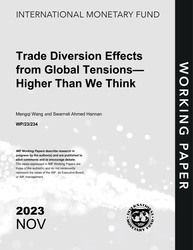
Trade Diversion Effects from Global Tensions—Higher Than We Think
Trade Diversion Effects from Global Tensions—Higher Than We Think
READ MORE...
Volume/Issue:
Volume 2023
Issue 234
Publication date: November 2023
ISBN: 9798400257421
$20.00
Add to Cart by clicking price of the language and format you'd like to purchase
Available Languages and Formats
| English |
Prices in red indicate formats that are not yet available but are forthcoming.
Topics covered in this book
This title contains information about the following subjects.
Click on a subject if you would like to see other titles with the same subjects.
Exports and Imports , Economics- Macroeconomics , Public Finance , Taxation - General , Economics / General , input-output linkages , trade diversion , U , S , -China trade tensions , trade diversion effect , magnitude of trade diversion , input-output datum , summary statistics of tariff exposure , change dummy , aggregate trade diversion effect , export share , Tariffs , Exports , Imports , Trade tensions , Valuation , origin and classification , Global
Summary
The paper builds a unique industry-level dataset by combining Mexico’s nationally sourced inputoutput data (INEGI) with cross-country sources (WIOD, UN Comtrade). Using this dataset to exploit higher supply linkages across a larger number of industries than what is available in cross-country sources, the paper estimates the trade diversion effect on Mexico’s exports to the U.S. from two episodes, with a focus on the first: the U.S.-China trade tension in 2018 and the U.S. sanctions on Russia in 2014. Difference-in-differences, local projections and few other empirical methodologies are used. For the first episode, the paper finds higher trade diversion effects than estimates in literature. Output tariff plays an important role, and there is some evidence of a positive impact through downstream tariffs. The effects are stronger when nationally sourced input-output data is used compared to those derived from cross-country sources. Importantly, the magnitude of trade diversion across industries does not depend on Mexico’s industry-level trade exposure to the U.S., but rather on the U.S. tariff changes on Chinese goods, the decrease in imports from China, product substitutability with Chinese products, and (weakly) on Mexico’s GVC integration. Similarly, for the second episode, the paper finds positive trade diversion effects. Overall, the findings suggest that trade diversion effect might be higher than previously thought and the proper accounting of dataset and supply linkages makes a difference.



